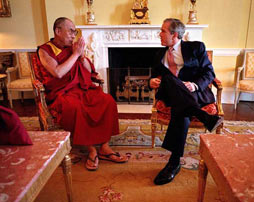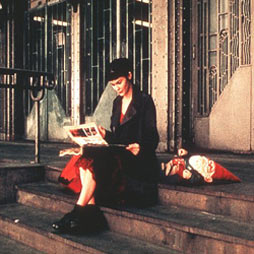By Katie Hudson-Martinez/feature editor

Protests around the globe this year have centered around the 2008 Beijing Olympic games and the ceremonial passing of the torch, illuminating once again the plight of Tibetans who seek autonomy from China.
Since the Chinese invasion of Tibet in 1950, there have been bombings, executions, imprisonments and the alleged kidnapping of a child holy leader and his family who vanished in 1995.
The conflict is far more complicated than most Americans may believe.
“Media outlets present the exiled government of Tibet almost as Saints, and their long-standing nonviolent approach to protest has drawn many to their cause, but this was not always their way of life,” Mike Olivares, a graduate student of history at the University of Texas, said.
ANCIENT HISTORY
The Tibetan Empire was once one of the most feared armies in Asia and controlled an area that stretched from Bengal to Mongolia. Even up to the point when Tibet completely lost its sovereignty for the last time, some have accused the Tibetan government of ruling with an iron fist.
A recent in-depth article written by Michael Parenti, a political scientist and college textbook author, includes interviews with Tibetans who lived in Tibet prior to the Chinese occupation in 1950. They speak of slavery, torture and sexual abuse of young people, as well as exorbitant taxes that went directly into the pockets of the Lama’s cabinet.
“Religious conflict was commonplace in old Tibet,” Parenti attributed to one western Buddhist practitioner. “History belies the Shangri-La image of Tibetan lamas and their followers living together in mutual tolerance and nonviolent goodwill.”
Many timelines on the history of the Tibet/Chinese conflict begin in 1913, when the Qinq Emperor abdicated his throne and Tibet once again declared its independence. But the conflict can be traced back as far as the seventh century when Tibet first became engaged in armed conflict with what was then Tang China.
During that time period, Tibet launched successful attacks on the Chinese and in the following century captured the capital city of Tang China, Chang’an.
“In 821, a peace treaty reached by Chinese and Tibetan officials declared, ‘Tibetans shall be happy in Tibet and Chinese shall be happy in China.’ It was signed by more than a dozen leaders from both sides,” Olivares said.
The full transcript of the agreement was inscribed on three stone pillars, one of which stands at the Jokhang Temple in Lhasa, Tibet.
After the assassination of Emperor Lang Dharma by a Buddhist Monk in 842, the empire fractured and split.
As the Mongolian empire spread across the Asian continent, Tibetans in the heartland later were forced to accept Mongolian leadership. It is because of the unification under Mongolian control that China maintains it has inherited the right to rule Tibet.
MODERN HISTORY
In the 19th century, the country was once again invaded, this time by Great Britain, whose main objective was to prevent the Russians from gaining control over the region.
“Western interference so close to home was perceived as threatening by Chinese officials who subsequently ordered their own invasion of Tibet,” Olivares said.
The Chinese army was driven out of Tibet as the Manchu Dynasty began to collapse, and the Republic of China was born in 1912.
Tibet and Mongolia once again established themselves as independent from China. But the tide was beginning to turn, and Tibet was no longer capable of holding its own against the growing military might of the Chinese.
On the heels of the end of World War II and the fall of the Ottoman Empire in the east, China broke into a civil war. The Republic of China gave way to the People’s Republic of China, a Communist government, in 1949, banishing the ROC to the outlying islands, namely Taiwan, and exerting Communist control over mainland China.
The PROC immediately invaded and annexed Tibet as a part of China, reportedly sending an army of 40,000 soldiers into Tibet and crushing any resistance. The Tibetans were forced to concede, and in 1951 signed the 17-Point Agreement with the Chinese. However, within the Tibetan communities, unrest continued to grow, which led to an uprising in 1956.
“The Chinese clamped down on the resistance hard forcing the 14th (and current) Dalai Lama to flee his homeland in 1959,” Olivares said. “He has not been allowed to return since.”
Several accounts in recent history tell of peaceful protests by Tibetan independence supporters ending in murder by Chinese troops and in the most recent incident, March 2008, conflicting reports placed the death toll between 22 and 99. Hundreds were arrested after Tibetans revolted and burned down Chinese-imposed businesses and shops in Tibet. They were demanding freedom and the return of the Penchant Lama who was arrested by Chinese forces in 1995 when he was just 5 years old.
THE DISAPPEARANCE OF A SPIRITUAL LEADER
In tradition with Tibetan Buddhist beliefs, there are two supreme religious leaders: the Dalai Lama and his second in command, the Panchen Lama. It is believed that when one of these men dies, his spirit will be reincarnated into a baby who is born around that time. This child is to be identified by the Lama who is still alive.
In 1989, the Panchen Lama died in exile, and the Dalai Lama set out on a spiritual quest to identify his successor. In 1995, The Dalai Lama announced that 6-year-old Gedhun Choekyi Nyima, who was born April 25, 1989, was the reincarnation of the Panchen Lama. Within days, the Chinese government arrested Nyima and his entire family, and they have never been seen again.
“Chinese official statements suggest that the boy is alive and well, but that his location is being kept secret ‘for his own protection’ although they have declined to say what it is he needs to be protected from,” Or Rajid, an American-born Buddhist, said. “I know it is only the Chinese government he needs protecting from.”
No aid organization or foreign government official has ever been allowed access to the boy, who would be 19 years old Friday.
The Chinese government has named its own Panchen Lama, a son of Communist Party officials, who they say is the true Panchen Lama, but Tibetans have not, by most reports, accepted this “new Lama” as their spiritual leader.
“The CRC is an atheist government, and so they can be distrusting toward religion,” Paul Frazier, associate professor of philosophy and religion on NW Campus, said. “It’s disturbing that they would want to pick the new Lama, taking that away from the true believers in Tibet. But if they can get one in that is in their favor, that Lama will choose the new Dalai Lama after his death and a greater degree of control can be attained over the area.”
PRESENT DAY TIBET
In a recent press conference, Qiangba Puncog, chairman of the Government of the Tibet Autonomous Region (a Communist Party official appointed to office by China), maintains that the riots were brought about by the Dalai Lama and reiterates that Tibet is the business of China. He said no one has the right to interfere in their internal affairs, adding that it wouldn’t work even if they tried.
“Our determination to safeguard unification of the motherland, unity of various nationalities and social stability will remain unchanged,” he said.
Chinese government officials point to the modernization of Tibet and the increase in GDP as a positive while the Dalai Lama has called it “cultural genocide.”
In a recent interview with Ann Curry, the Dalai Lama expressed a desire to retain cultural and religious autonomy without completely seceding from China.
“We are not anti-Chinese,” the Lama said. “We always respect and admire this Chinese civilization and Chinese people. And, as a Tibetan, almost 2,000 years, we live side by side.”
Only time will tell where the story goes from here, but most Tibetan independence supporters forge on seeking a fair resolution to the current situation.





























